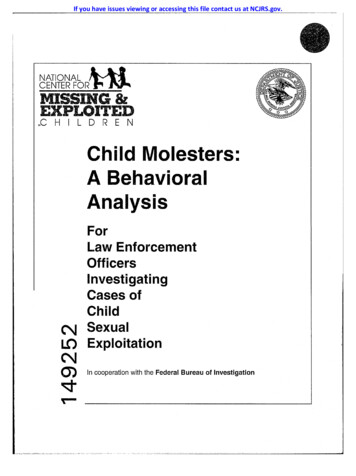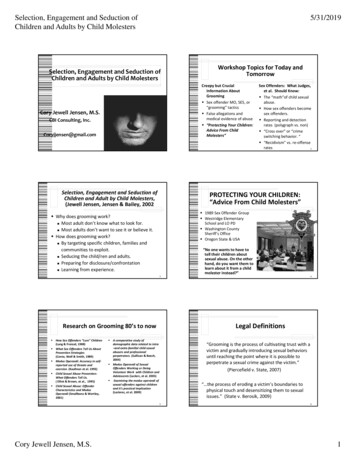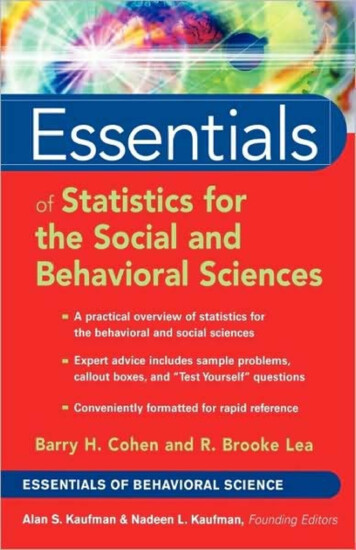
Transcription
If you have issues viewing or accessing this file contact us at NCJRS.gov.NATIONAL CENTER FORI-' MMISSING&EXPLOITED.CHILDRENChild Molesters:A BehavioralAnalysisForLaw EnforcementOfficersInvestigatingCases ofChildN SexualLO ExploitationNmIn cooperation with the Federal Bureau of Investigation r-
Child Molesters:A Behavioral AnalysisFor Law Enforcement OfficersInvestigating Cases ofChild Sexual ExploitationDecember 1992Third EditionKenneth V. LanningSupervisory Special AgentBehavioral Science UnitFederal Bureau of InvestigationFBI AcademyQuantico, Virginia National Center for Missing & Exploited Children
149252U.S. Department of JusticeNational Institute of JusticeThis document has been reproduced exactly as received from thep rson or organization originating it. Points of view or opinions stated InthiS document are those of the authors and do not necessarily represontthe official position or policies of the National Institute of Justice.Permission to reproduce this copyrighted material has beengr1iJa 1I1 ctr.for Missing&Exploited Children/DOJ/FBIto the National Criminal Justice Reference Service (NCJRS).Further reproduction outside of the NCJRS system requires permissionof the copyright owner.Prepared under Cooperative Agreement #86-MC-CX-K003 and revised and reprinted underCooperative Agreement #92-MC-CX-K001 from the Office of Juvenile Justice and Delinquency Prevention, Office ofJustice Assistance, Research, and Statistics, U.S. Deparhnent ofJustice.Points of view or opinions in this book are those of NCMEC and do not necessarily representthe official position or policies of the U.S. Deparhnent of Justice.A version of this book was published in Practical Aspects of Rape Investigation: A MultiDisciplinary Approach, edited by Robert R. Hazelwood and Ann W. Burgess (New York:Elsevier, 1987).
ContentsForeword v1. Definitions of Terms 1Child Molesters 1Pedophiles 1Important Distinctions for Law Enforcement 3Classification Typologies 42. A Law Enforcement Typology 5Needs of Law Enforcement 5Kinds of Child Molesters 5Situational Child Molesters 6Preferential Child Molesters 8The Role of Law Enforcement 93. Problem Areas 11Combination Offenders 11Sex Rings 11Incest Cases 12Female Offenders 13Adolescent Offenders 134. Identifying Pedophiles 15The Preferential Child Molester (Pedophile) 155. Collection of Child Pornography and Erotica 23Child Pornography 24Child Erotica (Pedophile Paraphernalia) 26Motivation for Collection 27Use of Collection 28Characteristics of Collection 29The Role of Law Enforcement 316. After Identification 37The Pedophile's Defenses 37
7. InvestiGtl.tive Difficulties 41The Ideal Victim 41Maligned Investigator 42What Constitutes Sexual Activity? 43Societal Attitudes 43Appendix I:Considerations in Obtaining and Using Expertise SearchWarrants in Cases of Preferential Child Molesters,by Janet E. Kosid, Esquire 45Appendix II:References 61Appendix III:Additional Reading 63Appendix IV:Cycle of Violence 65Appendix V:Sexual Victimization of Children 67
ForewordMuch valuable law enforcement training workis being done by the FBI Academy and National Academy, the Federal Law Enforcement Training Center, and the National Center for Missing and Exploited Children(NCMEC). In fact, through September 1992,NCME,C alone has trained more than 118,000officers nationwide and in Canada. Nonetheless, there is still a critical need in law enforcement for information and publications on specific investigative topics. Since its inception,NCMEC has published and distributed free ofcharge 260,000 copies of two such trainingpublications: Parental Kidnapping and theInvestigator's Guide to Missing Child Cases.In December 1989 NCMEC published acompanion text to Child Molesters: A BehavioralAnalysis, entitled Child Sex Rings: A BehavioralAnalysis, also by Kenneth Lanning, which presents the latest information on investigatingchild sex rings and ritualistic abuse. The second edition of this text was issued in April1992.Currently, a prime mission is to extend thefacilities of NCMEC to the law enforcementpractitioner community for the purpose of'publishing short books or monographs onsexually exploited children or pedophilesparticularly as these subjects relate to the missing child phenomenon. Our aim is to mergevarious U.S. Department of Justice initiativesfor proactive marketing in order to expand thepractical effect of all our efforts.As a society our efforts to prevent crimesagainst children have not kept pace with theincreasing vulnerability of our young citizens.In May 1990 the U.S. Department of Justicereleased a study reporting that in 1988 therewere as many as: 114,600 attempted abductions ofchildren by nonfamily members 4,600 abductions by nonfamilymembers reported to police 300 abductions by nonfamily members where the children were, gonefor long periods of time or weremurdered 354,000 children abducted by family members 450,700 children who rp'n awayo127,100 children who were thrownaway 438,200 children who were lost, injured, or otherwise missingThe link between missing and sexuallyexploited children is a -strong one. For example, from July 1980 through February 1984,the police / social work team of the Louisville /Jefferson County Exploited and Missing ChildUnit (EMCU) in Kentucky investigated approximately 1,400 cases of children suspectedof being victims of sexual exploitation. A full54 percent (756) of the children were found tobe victims and an additional 31 percent (434)of the children were considered probable victims. During this time period the EMCUprosecuted hundreds of adults for variouscrimes involving the sexual exploitation ofchildren. Over 40 major cases resulted in thesuccessful prosecution of adults involved withover 12 children each.Even though the EMCU was reputed to bethe national model of investigations in sexually exploited children by the end of the thirdyear of work, such was only to demonstrate aneffective" ambulance service at the base of thecliffs." A new approach was needed. As av
------------------------------proactive effort for the early intervention intothis cycle of sexual exploitation, the EMCUteam began handling all missing child cases inJefferson County, Kentucky, in January 1983.Now the EMCU began to "build fences at thetop of the cliffs."The data developed on the first 830 missing children indicated that approximately 10percent of the missing child population wasexploited while missing. Data further indicated that up to 85 percent of these commercially exploited children were missing at thetime of the exploitation offense.The EMCU's handling of missing childcases functioned as an early warning systemfor cases needing child protective services,counseling, or law enforcement services-allof which are vital for the successful detection,investigation, arrest, and prosecution of adultsin child sexual exploitation.Information gained through interviews,always both investigatory and therapeutic,kept tearn members very much aware of streetactivity, identified havens for missing youths,and allowed team members to "burn bridges"to hazardous environments and endangeringadults before the child could become sexuallyexploited. New investigatory techniques andmethodologies were developed and refinedwith an absolute ethic (and policy) that youthwere never to be used in any endangeringcapacity nor allowed to volunteer to do so tofurther an investigation. This backgroundexperience clearly indicated that the statusitself of being missing (runaway, homeless,abducted, etc.) is a very large window forentrance into child sexual exploitation.Furthermore, the cycle of violence (see Appendix IV,") now appears as beginning withchild abuse within the family and extending tomissing child episodes that present the arenafor exploitation of the child. With maturation,Ifvithe adult-abused as a child-becomes theabuser or exploiter. While there has beenactivity in social services research and analysis of the nature of and effects on child victimsof sexual exploitation, law enforcement hasbeen found wanting for reliable informationon the nature of the behavior and emotionalpatterns of child molesters to assist in theirdetection and apprehension.Any criminal behavior that appears consistently and universally must be recognizedas having high predictive and preventativevalue for law enforcement and child protective services. Of critical importance is thecomplexity of the dynamics, typology, andinvestigative handling of child molesters-alabel not always synonymous with pedophile.Supervisory Special Agent Kemleth V. Lanningof the Behavioral Science Unit at the FBI Academy has provided formative research andanalysis of this topic and, most important,tailored the approach to be of extreme practical importance to law enforcement investigators.Law enforcement is charged with the detection and observation of acts and behaviorsthat are violations of the law for which thechild molester can be charged and from whichchildren must be protected. While psychiatriclabels fall far short of being useful to the investigator, Mr. Lanning's typology offers a construct for investigators that provides insightand guidance in practicing child protectionnot just labeling it for treatment. The ability tounderstand and recognize the behavior of childmolesters before their arrest or identification isa prime weapon for the investigator handlingcases of sexual abuse or exploitation. If investigators can qetter understand how and 'Whymolesters have sex with children, child protection officials are in a much better position todetect, identify, arrest, convict, and obtain
sentencing that truly deters these horrid crimes.Such should also lead to another prime motivefor law enforcement-proving a case withoutnecessitating the use of children for testimonyin the court itself.Mr. Lanning has provided us with an excellent and useful treatment of the nature ofchild molesters as unique individuals withhighly specific and observable criminal behavior. Not all child molesters are the same.Stereotypes must be avoided. Mr. Lanninghas provided us the framework for an acuteunderstanding and recognition of the behavioral patterns that should enable investigatorsto function at a much higher level of professionalism.John B. Rabun, Jr., ACSWVice President andChief Operating OfficerNCMECvii
1. Definitions of TermsChild MolestersThe term child molester is fairly common and isused by professionals and nonprofessionalsalike, including law enforcement officers.Although Webster's New World Dictionary defines molest as annoy, interfere with, or meddlewith so as to trouble or harm," when combined with the word child, it has generallycome to convey sexual abuse of some type.In spite of its common usage, it is surprising how many differentimages and variationsof meanings the term child molester has fordifferent individuals. For many, it brings tomind the image of the dirty old man in awrinkled raincoat hanging around a schoolplayground with a bag of candy, waiting tolure little children. For some, the child molester is as tranger to his victim and not a fa therhaving sex with his daughter. For others, thechild molester is one who exposes himself toor fondles children without engaging in vaginal or anal intercourse. Still others believe thechild molester is a nonviolent offender. Dr. A.Nicholas Groth, one of the leading experts onsexual victimization of children, differentiatesbetween nonviolent child molesters who coaxor pressure the child into sexual activity andviolent child rapists who overpower orthreaten to harm their victims (see "AppendixII: References"). Most would probably notapply the term child molester to a man whoutilizes the services of an adolescent prostitute. For law enforcement officers, the termchild molester is more likely to conform to alegal definition of sexual molestation set forthin the penal code.IfFor the purposes of this book, a child molester will be defined as a significantly olderindividual who engages in any type of sexualactivity with individuals legally defined aschildren. When using the term child molester,no distinctions will be made between male orfemale, single or repeat offenders, or violentor nonviolent offenders. No distinctions willbe made as to whether the child victims areprepubescent or pubescent, known or unknown, related or unrelated to the offender.Finally, no distinctions will be made based onthe type of sexual activity engaged in by theoffender. Although such distinctions mayhave important legal and evaluation significance, they have no bearing on whether or notan individual is labeled a child molester. Forlaw enforcement purposes, a child molester issimply an individual who engages in illegalsexual activity with children.PedophilesAlthough the use of the term child molester iscommonplace, recent publicity and awareness concerning sexual abuse of children hasresulted in the frequent use of the termpedophile. At one time this term was almostexclusively used by psychologists and psychiatrists. Dr. Groth's categorization defines achild molester as having a sexual attractiontoward prepubertal children (pedophilia) orsexual attraction toward pubertal children(hebephilia). The term hebephile (sometimesspelled ephebophilia) is rarely used today, evenby mental health professionals. Althoughsexual attraction to pubescent children by1
----------adults has the obvious potential for criminalactivity, it does not necessarily constitute asexual perversion as defined by psychiatry.However, many people, including the media,now routinely refer to those who sexuallyabuse children as pedophiles. This term isbeing used more and more by law enforce ment personnel. It has even entered theirslang usage-with some officers talking aboutinvestigating a "pedo case" or being assignedto a "pedo squad."The Diagnostic and Statistical Manual ofMental Disorders (DSM-III-R) of the AmericanPsychiatric Association contains the follow ing definition: "302.20 Pedophilia. The es sential feature of this disorder is recurrent,intense, sexual urges and sexually arousingfantasies, of at least six months' duration, involving sexual activity with a prepubescentchild. The person has acted on these urges, oris markedly distressed by them. The age of thechild is generally 13 or younger. The age of theperson is arbitrarily set at age 16 years or olderand at least 5 years older than the child" (see"Appendix II: References"). There are severalcriteria in this definition that must be empha sized. First, it mentions both the act and thefantasy of engaging in sexual activity. Whetheror not a person acts on the deviant sexualurges may be influenced by other factors suchas personality traits, the severity ofpsychosocial stresf Drs, or substance abuse. Asexual deviancy is commonly considered asbehavior that is not normal, and adults havingsex with and! or a sexual attraction to childrenis considered beyond the norm. Second, itrefers to this sexual activity as occurring withprepubescent children. In spite of this, manymental health professionals continue to applythe term to those with a sexual preference forpubescentteenagers. In DSM-III-R pedophiliais classified as a paraphilia, one of the psycho-2'---------- - --- --sexual disorders. Technically, pedophilia is apsychiatric diagnosis that can only be made byqualified psychologists or psychiatrists. Therefore, for many, the word is a diagnostic term,not a legal one.Its increasing use has, however, to somedegree brought this term outside the exclusivepurview of psychiatric diagnosis. Just as someone can refer to another as being "paranoid"without implying a psychiatric diagnosis orassuming psychiatric expertise, a socialworker, prosecutor, or law enforcement officer can refer to an individual who has sexuallyvictimized a child as a pedophile. Webster'sNew Collegiate Dictionary contains a goodlayman's definition for pedophilia: "sexualperversion in which children are the preferredsexual object." For the purposes of this book,a pedophile will be defined as a significantlyolder individual who prefers to have sex withindividuals legally q:msidered children. Thepedophile is one whose sexual fantasies anderotic imagery focus on children. The law, notpuberty! determines who is a child.It is important to realize that to refer tosomeone as a pedophile is to say only that theindividual has a sexual preference for children. It says little or nothing about the otheraspects of his character and personality. Toassume that someone is not a pedophile simply because he is nice, goes to church, workshard, is kind to animals, and so on, is absurd.Pedophiles span the full spectrum from saintsto monsters. In spite of this fact, over and overagain pedophiles are not recognized, investigated, charged, convicted, or sent to prisonsimply because they are "nice guys."It is also importantto recognize that, whilepedophiles prefer to have sex with children,they can and do have sex with adults. Adultsexual rela tionships are more difficult for somepedophiles than for others. Some pedophiles
have sex with adults as part of their effort togain or continue their access to preferred children. For example/one might have occasionalsex with a single mother to insure continuedaccess to her children. (See also Child Sex Rings:A Behavioral Analysis listed in Appendix III:Additional Reading.")/IImportant Distinctions forLaw EnforcementWhat, then, is the difference between a childmolester and a pedophile? For many theterms have become synonymous. The mediafrequently make no distinction and use theterms interchangeably. Labeling all childmolesters as pedophiles is, however, confusing. There are clear differences between thetypes of individuals who sexually abuse children, and law enforcement officers handlingthese cases need to make such distinctions.Are all pedophiles child molesters? No. Aperson suffering from any paraphilia can legally engage in it simply by fantasizing andmasturbating. A child molester is an individual who sexually molests children. A person might have a sexual preference for children and might fantasize about having sexwith them. That person is a pedophile. But ifhe does not act out, then he is not a childmolester. Some pedophiles might act outtheirfantasies in legal ways by simply talking to orwatching children and later masturbating.Some might have sex with dolls and mannequins that resemble children. Some pedophilesmight act out their fantasies in legal ways byengaging in sexual activity with adults wholook (small stature, flat chested, no body hair),dress, or act (immature, baby talk) like children. Others may act out child fantasy gameswith adult prostitutes. A difficult problem todetect and address is that of individuals whoact out their sexual fantasies by socially interacting with children or by interjecting themselves into the child sexual abuse or exploitation "problem" as overzealous child advocates. It is almost impossible to estimate howmany pedophiles exist who have never molested a child. What society can or should dowith regard to such individuals is an interesting area for discussion but beyond the role oflawenforcement. People cannot be arrestedfor their fantasies. It is 1! ot clear whether anyof these behaviors constitutes having "actedupon these urges" as required by the DSM-IIIR criteria for pedophilia.Are all child molesters pedophiles? No. Apedophile is an individual who prefers tohave sex with children. A person who prefersto have sex with an adult partner may, for anynumber of reasons, decide to have sex with achild. Such reasons might include simpleavailability, curiosity, or a desire to hurt aloved one of the molested child. The sexualfantasies of such individuals do not necessarily focus on children, and these people are notpedophiles.Many child molesters are, in fact,pedophiles, and many pedophiles are childmolesters. But they are not necessarily oneand the same. The law enforcement officermight argue that it is his job to arrest individuals who violate the law and that whether or notthat offender is a pedophile is of no importance to him. Distinctions between the typesof child molesters, however, can have important and valuable implications for the lawenforcement investigation of child sexualabuse.This book will set forth a model for lawenforcement that divides child molesters intotwo broad categories and several patterns ofbehavior. These categories are not intendedfor use by mental health professionals or clini-3
cians. They are intended for use by law enforcement officers and prosecutors in developing the evidence needed to identify, arrest,and convict child molesters. If the investigating officer already has enough evidence toconvict a child molester, then it may be ofsmall importance whether the molester is apedophile or not. But if the investigator is stillattempting to develop incriminating evidence,such distinctions can be invaluable. Even ifthere is enough evidence to convict a childmolester, the fact that a molesterisa pedophilecould still be important in evaluating the potential for additional child victims.Classification TypologiesProbably the first, and maybe still the mostcommon, classification typology for child molesters is the one developed by Dr. Groth, whoclassifies sexual offenders against children intotwo groups on the basis of whether this involvement constitutes a persistent pattern (afixation) or a new activity or change (a regression) in their sexual orientations or lifestyles.Dr. Groth further explains that the FixatedChild Molester is one ':whose primary sexualorientation is towards children," and the Regressed Child Molester is one "whose sexualinvolvement with a child is a clear departure,under stress, from a primary sexual orienta-4Hon towards agema tes." In essence, Dr. Groth'sFixated Child Molester prefers children forsexual partners and identifies closely withthem. The Regressed Child Molester prefersagemates for sexual partners but, because ofsome precipitating stress in his life, he substitutes a child for the troubled adult relationship (see Appendix II: References").A more recent classifica tion typology is theoile developed by Raymond A. Knight, Ph.D.,and Robert A. Prentky, Ph.D., that classifieschild molesters based on the following fiveelements: social competence, sexual preoccupation with children, nonoffense contact withchildren, physical injury to child, and sadism.The typology was empirically developedthrough statistical analysis and is technicallyreferred to as factor analytically derived taxonomy. Although it sounds complicated, thetypology makes sense and provides usefulinsights for criminal justice professionals. It isbeing utilized in the Case in Point series published by the National Center for 1tIissing andExploited Children to classify the offendersinterviewed for research purposes by the FBI.Both of these classification systems weredeveloped for and are used primarily by psychologists evaluating and treating child molesters. These two systems and the DSM-III-Rdiagnostic system require that the offender beidentified and available for evaluation./I
2. A Law Enforcement TypologyToo often the terms child molester and pedophileare used interchangeably or without definingthem. In fact, not all child molesters arepedophiles, and there is a clear need for a lawenforcement typology to clear up the conf1.1sion. Law enforcement has frequently accepted offender categories and characteristicsdeveloped by therapists and criminologists.These typologies, however, primarily servethe needs of mental health professionals andhave limited application to those of law enforcement. These typologies are usually developed from data collected from offendersafter arrest or conviction and often reflectunsubstantiated information about pre-arrestbehavior. It is the pre-arrest or pre-identification behavior of child molesters that is of mostvalue to law enforcement.In addition, law enforcement usually doesnot have the luxury of having a known, confessed offender in front of them. Lawenforcement and prosecutors need a typology thatcan be applied before the perpetrator is identified or the case is proven in court.strong case that the perpetrator pleads guiltyand there is no trial. This may not always bepossible, but it should be the investigativegoal. Many children can testify in court ifnecessary.The child victim should be carefully interviewed. The information obtained should beevaluated and assessed, and appropriate investigative action should be taken. The investigator, however, should proceed as thoughhe or she has information about a crime froma reliable source whose identity cannot berevealed. The investigator should be an objective fact finder attempting to determine whathappened.One way to avoid child victim testimony isto avail yourself of other evidence that mighthelp prove the case. Frequently there is moreevidence available than the investigator realizes.Much of this evidence can be identifiedand located only if the investigator has a solidunderstanding of offender behavior patternsand the kinds of child molesters.Kinds of Child MolestersNeeds of Law EnforcementChild sexual abuse cases can be difficult toprove. Frequently there is only the word of achild against that of an adult. Many factorscombine to make it difficult and possibly traumatic for children to testify in court. In spite ofsome recent advances that make testimonyeasier for the child victim or witness, an importantobjective of every investigation of childsexual abuse should be to prove the case without resorting to the courtroom testimony ofthe child. This is best done by building such aDr. Park Elliot Dietz divides sex offenders intotwo broad categories: situational and preferential (see Appendix II: ReferencesThisconcept can be of great practical value to lawenforcement. After consulting on hundreds ofcases in his work at the FBI Behavioral ScienceUnit and not finding a typology that fits lawenforcement needs, the author decided to develop his own. Expanding on Dr. Dietz's idea,the author developed a typology of child molesters for criminal justice professionals. Theauthor has deliberately avoided all use of diflII).5
agnostic terminology and used instead descriptive terms. The purpose of the typologybeing set forth in this book is not to gain insightor understanding about why child molestershave sex with children in order to help or treatthem, but to recognize and evaluate how childmolesters have sex with children in order toidentify, arrest, and convict them. What evidence to look for, whether there are additionalvictims, how to interview a suspect, and so on,depend on the type of child molester involved.Situational Child MolestersThe Situational Child Molester does not havea true sexual preference for children, but engages in sex with children for varied andsometimes complex reasons. For such a childmolester, sex with children may range from a"once-in-a-lifetime" act to along-term patternof behavior. The more long-term the patternis, the harder it is to distinguish from preferential molesting. The Situational Child Molesterusually has fewer numbers of different childvictims. Other vulnerable individuals, such asthe elderly, sick, or the disabled, may also be ata risk of sexual victimization by him or her.For example, the Situational Child Molesterwho sexually abuses children in a daycarecenter might leave that job and begin to sexually abuse elderly people in a nursing home. Itis the author's undocumented opinion that thenumber of Situational Child Molesters is largerand increasing faster than that of PreferentialChild Molesters. Members of lower socioeconomic groups tend to be overrepresentedamong Situational Child Molesters. Withinthis category at least four major patterns ofbehavior emerge (see also Table 1 on page 10).6Regressed Such an offender usually has lowself-esteem and poor coping skills; he turns tochildren as a sexual substitute for the preferred peer sex partner. Precipitating stressmay playa bigger role in his molesting behavior. His main victim criterion seems to beavailability, which is why many of these offenders molest their own children. His principal method of 9peration is to coerce the childinto having sex. This type of Situational ChildMolester mayor may not collect child or adultpornography. If he does have child pornography, it will usually be the best kind from aninvestigative point of view: homemade photographs or videos of the child he is molesting.Although this type of child molester may bevery common, not many cases involving thispattern of behavior are referred to the FBIBehavioral Science Unit for case consultation.Morally Indiscriminate In the author's experience, this is a growing category of chi dmolesters. For this individual, the sexual abuseof children is simply part of a general patternof abuse in his life. He is a user and abuser ofpeople. He abuses his wife, friends, coworkers. He lies, cheats, or steals whenever hethinks he can get away with it. He molestschildren for a simple reason: "Why not?" Hisprimary victim criteria are vulnerability andopportunity. He has the urge, a child is there,and so he acts. He typically uses force, lures,or manipulation to obtain his victims. He mayviolently or nonviolently abduct his victims.Although his victims frequently are strangersor acquaintances, it is impo tant for the investigator to realize that his victims can also be theoffender's own children. The incestuous father or mother might be this morally indiscriminate offender. He frequently collectsdeLctive magazines or adult pornography ofa sadomasochistic nature. He may collect
some child pornography, especially that whichdepicts pubescent children. Because he is animpulsive person who lacks conscience, he isan especially high risk to molest pubescentchildren. Such acts may be cr
apply the term child molester to a man who utilizes the services of an adolescent prosti tute. For law enforcement officers, the term child molester is more likely to conform to a legal definition of sexual molestation set forth in the penal code. For the purposes of this book, a










